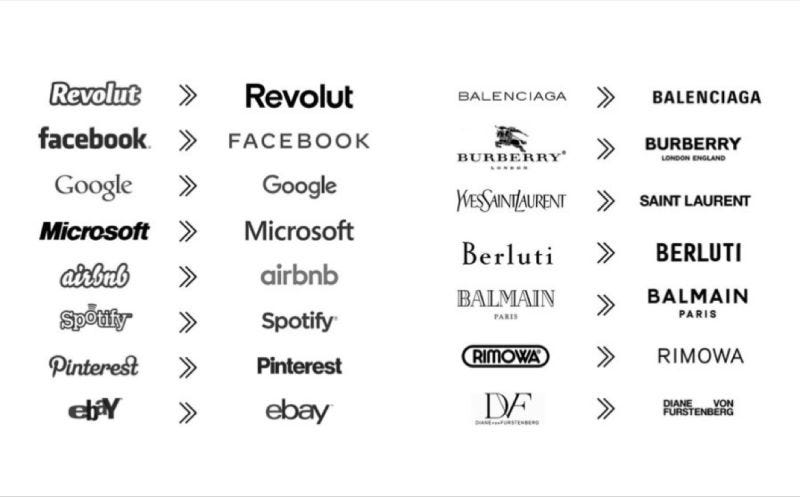A word of advice for nervous founders and executives. If you’re yearning for someone to tell you what your brand “really is,” stop. Forget it. Find a good psychologist instead.
The current marketing regime demands you pay an agency to rebrand your company. This despite historical precedent
that successful rebrands are almost always fast, practical decisions emanating from the clear vision of a founder. Yet inside branding agencies, hundreds of logo variations cover the walls: a thicker line here, an oval instead of a circle there, and this one, oh with this one we really went wild.
The brand mark is just the tip of the iceberg. Before the logo phase, thousands of billable hours and hundreds of deck slides are spent “defining the brand,”—essentially a months-long career coaching session complete with Jungian archetype wheels and lengthy manifestos. For big companies, the process costs hundreds of thousands of dollars.
It’s mostly an exercise in absolute futility. Presenting a zillion slightly modified versions of a refreshed brand mark is every bit as absurd as presenting a zillion slightly modified versions of a tagline. Imagine Motel 6 executives sitting in a room juggling “We’ll Leave the Light on For You,” “We’ll Keep the Lights On for You,” “We Leave the Lights on for You,” “The Lights, We Keep ‘Em On.” If they had, their iconic campaign
would’ve surely died the death of a thousand cuts before its debut. Rather, like the rebrands of Nike, Apple, McDonald’s, “We’ll Leave the Lights on for You,” was a split second decision, an ad-lib by spokesperson Tom Bodett.
Once one enters the pedantic, narcissistic mind space of “the rebranding process,” the whole enterprise dissolves into mediocrity. To justify their paychecks, WFH product managers
offer this and that reason why this or that aspect absolutely must be changed and you arrive at the lowest common denominator. Hence the milquetoast fate of today’s biggest brands:

Brands are a natural reflection of their founders. They are best expressed over time via the execution of products and content, not masturbatory workshopping. Paying a bunch of technocrats to think and talk about your rebrand for weeks on end is not only pointless, it’s harmful. Better to save your money. Accept rebranding for what it is. A simple process to be done quickly, affordably, and for good business reasons. Remember, the Swoosh cost two meetings and $35.
Rebranding is Never Great, Only Good
So this of course raises the question of specifics: what should a company do when it needs to rebrand?
Here’s the tale of two Oregon universities.
In the mid-2010s, university branding became popular. Schools signed multi-million dollar contracts with agencies who promised to excite prospective students with brand work radically different from the boring old “three and a tree
.”
Sometimes these rebrands went smoothly. Nike, for example, first overhauled Oregon State’s brand (athletics only) in 2013. It was refreshed even more by Pentagram and Ologie in 2017, who gave it a new look and the tagline “Out There.” The project cost roughly half a million dollars. OSU stakeholders received it well. Attendance crept upwards after its unveiling, and the brand remains in place today.
https://vimeo.com/212328595?embedded=true&source=vimeo_logo&owner=5783320
Oregon University experienced the exact opposite. It attempted a rebrand in 2016 with the new slogan “We If,” more suitable for a bad Silicon Valley startup than an established University. Students, boosters, and alumni revolted
, calling it vague, naive, and disrespectful to school tradition. OU had no choice but to cut ties with its branding agency early…but not before wasting $5 million on the project.
https://youtu.be/6fvPsoidQmI
OU’s five million dollar rebranding fail about Exploring the power of “if”
What’s the takeaway? That a good rebrand is a necessary condition for business success, but not a sufficient one. Launch a solid new brand, and things will improve for your company, you'll attract more customers, and your stakeholders will be happy. But you probably won’t receive a massive outpouring of adoration.
Launch a bad one, however, and you could throw millions of dollars down the drain and embarrass your organization and everyone in it. Lots of people can lose their jobs.
A good rebrand isn’t enough for success, but a bad rebrand is more than sufficient for total failure.
TL;DR: when preparing for a rebrand, don’t expect to break the internet unless your new brand really sucks.
Keep a Pragmatic Mindset
Like everything in marketing, the answer to whether you’ve launched a good new brand or a bad one is “it depends on your objective.” And, like everything else in marketing, the key to success is pragmatism.
Slack had good reason to rebrand in 2019. Their existing colorful hashtag logo had 11 different colors. It also had a distinctive 18° tilt, which was crazy-making for designers trying to interpret the brand consistently. As a result, Slack’s brand identity was falling apart.

So they went with a simpler, more familiar four color design usable across many platforms. But people absolutely hated it. They said it was a ripoff. Indistinguishable from other logos. That it betrayed Slack’s quirky, “we get it” personality. People compared the new logo to both a butthole and swastika, a fate so common for new brands that it should be a universal law.
Was Slack’s rebrand a failure?
Not at all. People forgot about it in a week. Slack continued its upward trajectory. From a publicity standpoint, the “branding fail” was an overwhelming success. And Slack got a new brand it could actually use.
Solve a Problem, Don’t Change the World
Good rebrands are boring, more like software updates than revolutions. Slack executed a practical brand solution to a practical brand problem, and that’s why it succeeded. Here’s another example: Comcast needed to shake the scent of a horrible reputation (speaking of swastikas
), so they turned themselves into the forgettable Xfinity. It totally worked. They went from America's most-hated brand, to America's most kinda-hated-but-tolerated brand.
That’s not to say, however, that just solving a problem is enough. Take Radio Shack. Having become a punchline by 2009, it decided that the “radio” part of its name was holding it back, and it may very well have been right. So instead of changing itself to something rational or in any way not idiotic, it tried to switch to “The Shack,” and launched a campaign around “Our Friends Call us The Shack.”
Needless to say it was a total disaster.

Rebranding failures usually result from unclear reasoning and lofty dreams—the vague desire for something new and different. Another example. Tropicana spent $35 million to replace their beloved brand simply to “evolve the brand” to something more modern. It lost $20 million in sales in the first month, and the company quickly retreated back to the old look.

How to Plan for a Successful Rebrand
Rebrands predictably fail when they're done for the wrong reasons. Instead of focusing on concrete goals, they’re driven by change for the sake of change. They dream of going down in history, of transcending mere brandhood and entering the realm of the most coveted of all Hype Dad
titles: “World Changer.”
Bad branding agencies—e.g. almost all branding agencies— are a lot like bad therapists: they suck away all your money not because they’re effective, but because they’re great at massaging your ego. Instead of working to understand existing stakeholders, they fantasize about new personas and new demographics. Instead of taking calculated risks, they take radical ones for no good reason.
My advice is twofold. Option one: don’t hire a branding agency and do it yourself. Hire people to create the designs and content you need to express your brand, not tell you what it all means. Two: if you do hire a branding agency, hire one to do what Slack did or what Xfinity did. Update your brand. Don’t try to make it mean more than that.
In other words, preparing for a successful rebrand is the opposite of preparing for a “Big Idea” advertising campaign. Any rebrand that breaks the internet is almost certainly going to be a disastrous one. Keep your mind on concrete business needs, set expectations, and check the hype at the door.
Understated innovation is sometimes the best kind. The best designers are minimalists: experts at throwing away everything they don’t need. So don’t be afraid to do less. Solve a problem. Update your software. And keep growing in the right direction.